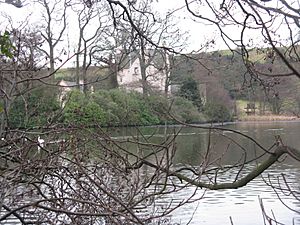Couston Castle facts for kids
Couston Castle is an old and interesting building in Scotland. It's a special type of castle called an L-plan tower house. This means it has a main rectangular part with another smaller part sticking out, making it look like the letter 'L'. It was built a long time ago, around the late 1500s or early 1600s. You can find it near Dalgety Bay in Fife, right by Otterston Loch. It was built on the spot where an even older building once stood.
Contents
The Story of Couston Castle
Early Beginnings and Royal Connections
The land where Couston Castle stands was first given to Robert de London in 1199. Robert was a son of King William the Lion, who ruled Scotland from 1165 to 1214. Later, the land was passed to Roger Frebern.
Owners Through the Centuries
Couston Castle was first owned by the Logan family from Restalrig. After some time, it became the property of the Earls of Moray. By the 1500s, it was a strong castle, built to protect itself with cannons. King James V of Scotland confirmed that James Logan of Couston owned the castle. The Logan family lived there during this time. They also updated the castle to look mostly as it does today.
Famous Residents and Changes
For part of the late 1600s, a famous Presbyterian clergyman named Robert Blair lived at the castle. He had even been a teacher to King Charles I of England. Robert Blair passed away at Couston Castle in 1666.
The northern part of the castle was likely added in the 1700s. Couston Castle was in good shape until the 1830s. Sadly, a large part of the southern end was taken down. Its stones were used to build nearby farm buildings.
Bringing the Castle Back to Life
After many years of being empty and falling apart, Couston Castle got a new chance. In 1980, a businessman from Dunfermline named Alastair Harper bought the castle. He decided to bring it back to life.
In 1985, an architect named Ian Begg helped restore the castle. He turned it into a family home. More improvements and additions were completed in 2002. Today, Couston Castle stands as a beautiful example of Scottish history.


